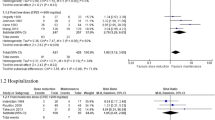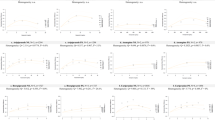Abstract
Rationale
Risperidone doses for acute schizophrenia were rather high in most recent studies.
Objectives
We tested a hypothesis that fine-tuning risperidone dosage to relieve side effects still yields efficacy. Clinical factors influencing the dosing were also determined.
Methods
One hundred and forty-six schizophrenia inpatients with acute exacerbation entered a prospective, 6-week, repeated measures study. Risperidone doses were titrated to 6 mg/day (if tolerable) within 7 days, but were lowered thereafter if adverse reactions appeared. Efficacy and safety were measured biweekly.
Results
Forty-eight patients tolerated the 6-mg/day target dose well, while the other 98 received lower final doses (mean±SD=3.4±0.9 mg/day) to curtail adverse effects. At endpoint, 64.3% of the low-dose patients and 43.8% of the high-dose subjects responded to treatment [≥20% reduction in the Positive and Negative Syndrome Scale (PANSS) total score] (P=0.018). In detail, the low-dose individuals were significantly superior in percentage changes in the PANSS total and general-subscale scores at endpoint. The low-dose group also tended to improve more (albeit statistically insignificantly) in the PANSS positive and negative subscales and other efficacy measures. Compared to the patients with undifferentiated subtype, those with disorganized subtype received higher dosage by 0.90 mg/day, after controlling for other variables (P=0.008). Paranoid subtype was similar to undifferentiated subtype in drug doses. Patients with longer illness duration also showed a trend to use higher dosage (P=0.078).
Conclusions
These findings suggest that dosage adjustment to diminish side effects does not compromise risperidone response and that disorganized patients and perhaps patients with longer illness duration are prone to receive larger doses.
Similar content being viewed by others
References
American Psychiatric Association (1994) Structured clinical interview for DSM-IV. American Psychiatric Press, Washington, D.C.
Anderson C, True J, Ereshefsky L, Miller A (1994) Risperidone clinical efficacy: role of the metabolite 9-hydroxy-risperidone [abstract]. Psychopharmacol Bull 30:88
Blin O, Azorin JM, Bouhours P (1996) Antipsychotic and anxiolytic properties of risperidone, haloperidol, and methotrimeprazine in schizophrenic patients. J Clin Psychopharmacol 16:38–44
Bondolfi G, Dufour H, Patris M, May JP, Billeter U, Eap CB, Baumann P (1998) Risperidone versus clozapine in treatment-resistant chronic schizophrenia: a randomized double-blind study. Am J Psychiatry 155:499–504
Bouchard RH, Merette C, Pourcher E, Demers MF, Villeneuve J, Roy-Gagnon MH, Gauthier Y, Cliche D, Labelle A, Filteau MJ, Roy MA, Maziade M (2000) Longitudinal comparative study of risperidone and conventional neuroleptics for treating patients with schizophrenia. J Clin Psychopharmacol 20:295–304
Bruder GE, Kayser J, Tenke CE, Friedman M, Malaspina D, Gorman JM (2001) Event-related potentials in schizophrenia during tonal and phonetic oddball tasks: relations to diagnostic subtype, symptom features and verbal memory. Biol Psychiatry 50:447–452
Chakos MH, Mayerhoff DI, Loebel AD, Alvir JM, Lieberman JA (1992) Incidence and correlates of acute extrapyramidal symptoms in first episode of schizophrenia. Psychopharmacol Bull 28:81–86
Chouinard G, Ross-Chouinard A, Annable L, Jones BD (1980) The Extrapyramidal Symptom Rating Scale [abstract]. Can J Neurol Sci 7:233
Chouinard G, Jones B, Remington G, Bloom D, Addington D, Macewan GW, Labelle A, Beauclair L, Arnott W (1993) A Canadian multicenter placebo-controlled study of fixed doses of risperidone and haloperidol in the treatment of chronic schizophrenic patients. J Clin Psychopharmacol 13:25–40
Collaborative Working Group on Clinical Trial Evaluations (1998) Clinical development of atypical antipsychotics: research design and evaluation. J Clin Psychiatry 59 (suppl 12):10–16
Csernansky JG, Prosser E, Kaplan J, Mahler E, Berger PA, Hollister LE (1986) Possible associations among plasma prolactin levels, tardive dyskinesia, and paranoia in treated male schizophrenics. Biol Psychiatry 21:632–642
Csernansky JG, Mahmoud R, Brenner R (2002) A comparison of risperidone and haloperidol for the prevention of relapse in patients with schizophrenia. N Engl J Med 346:16–22
Darby JK, Pasta DJ, Elfand L, Dabiri L, Clark L, Herbert J (1997) Risperidone dose and blood level variability: accumulation effects and interindividual and intraindividual variability in the nonresponder patient in the clinical practice setting. J Clin Psychopharmacol 17:478–484
Gutierrez-Esteinou R, Grebb JA (1997) Risperidone: an analysis of the first three years in general use. Int Clin Psychopharmacol 12 (suppl 4):3–10
Guy W (1976) ECDEU Assessment manual for psychopharmacology, revised. US Department of Health, Education, and Welfare publication (ADM) 76-338. National Institute of Mental Health, Rockville, Md., pp 217–222
Honigfeld G, Klett G (1965) The Nurses’ Observation Scale for Inpatients Evaluation: a new scale for measuring improvement in chronic schizophrenia. J Clin Psychol 21:65–71
Hoyberg OJ, Fensbo C, Remvig J, Lingjaerde O, Sloth-Nielsen M, Salvesen I (1993) Risperidone versus perphenazine in the treatment of chronic schizophrenic patients with acute exacerbations. Acta Psychiatr Scand 88:395–402
Huttunen MO, Piepponen T, Rantanen H, Larmo I, Nyholm R, Raitasuo V (1995) Risperidone versus zuclopenthixol in the treatment of acute schizophrenic episodes: a double-blind parallel-group trial. Acta Psychiatr Scand 91:271–277
Kane J, Honigfeld G, Singer J, Meltzer H (1988) Clozapine for the treatment-resistant schizophrenic. Arch Gen Psychiatry 45:789–796
Kapur S, Seeman P (2001) Does fast dissociation from the dopamine D2 receptor explain the action of atypical antipsychotics?: A new hypothesis. Am J Psychiatry 158:360–369
Kasper S (1998) Risperidone and olanzapine: optimal dosing for efficacy and tolerability in patients with schizophrenia. Int Clin Psychopharmacol 13:253–262
Kay SR, Fiszbein A, Opler LA (1987) The Positive and Negative Syndrome Scale (PANSS) for schizophrenia. Schizophr Bull 13:261–276
Klieser E, Lehmann E, Kinzler E, Wurthmann C, Heinrich K (1995) Randomized, double-blind, controlled trial of risperidone versus clozapine in patients with chronic schizophrenia. J Clin Psychopharmacol 15 (suppl 1):45–51
Kopala LC, Good KP, Honer WG (1997) Extrapyramidal signs and clinical symptoms in first-episode schizophrenia: response to low-dose risperidone. J Clin Psychopharmacol 17:308–313
Lane HY, Chang WH (1998) Risperidone-carbamazepine interactions: cytochrome P450 3A involved [letter]? J Clin Psychiatry 59:430–431
Lane HY, Chang YC, Chang WH, Lin SK, Tseng YT, Jann MW (1999) Effects of gender and age on plasma levels of clozapine and its metabolites: analyzed by critical statistics. J Clin Psychiatry 60:36–40
Lane HY, Chiu WC, Chou JCY, Wu ST, Su MH, Chang WH (2000) Risperidone in acutely exacerbated schizophrenia: dosing strategies and plasma levels. J Clin Psychiatry 61:209–214
Lane HY, Chang WH, Chiu CC, Huang MC, Lee SH, Chen JY (2001) A pilot double-blind, dose-comparison study of risperidone in drug-naive, first-episode schizophrenia [letter]. J Clin Psychiatry 62:994–995
Lane HY, Chang YC, Chiu CC, Chen ML, Hsieh MH, Chang WH (2002) Association of risperidone treatment response with a polymorphism in the 5-HT2A receptor gene. Am J Psychiatry 159:1593–1595
Lindenmayer JP, Iskander A, Park M, Apergi FS, Czobor P, Smith R, Allen D (1998) Clinical and neurocognitive effects of clozapine and risperidone in treatment-refractory schizophrenic patients: a prospective study. J Clin Psychiatry 59:521–527
Lingjaerde O, Ahlfors UG, Bech P, Dencker SJ, Elgen K (1987) The UKU side effect rating scale. A new comprehensive ration scale for psychotropic drugs and a cross-sectional study of side effects in neuroleptic-treated patients. Acta Psychiatr Scand Suppl 334:1–100
Marder SR, Meibach RC (1994) Risperidone in the treatment of schizophrenia. Am J Psychiatry 151:828–835
Melkersson KI, Hulting AL, Rane AJ (2001) Dose requirement and prolactin elevation of antipsychotics in male and female patients with schizophrenia or related psychoses. Br J Clin Pharmacol 51:317–324
Pappas D, Konitsiotis S, Liakos A (1997) Risperidone in the treatment of acute schizophrenic episodes [abstract]. Eur Neuropsychopharmacol 7 (suppl 2):206
Peuskens J, Bech P, Moller HJ, Bale R, Fleurot O, Rein W (1999) Amisulpride vs. risperidone in the treatment of acute exacerbations of schizophrenia. Amisulpride study group. Psychiatry Res 88:107–117
SAS Institute Inc. (1999) SAS OnlineDoc(R), Version 8, SAS Institute Inc, Cary, N.C.
Seeman MV, Lang M (1990) The role of estrogens in schizophrenia gender differences. Schizophr Bull 16:185–194
Stober G, Syagailo YV, Okladnova O, Jungkunz G, Knapp M, Beckmann H, Lesch KP (1999) Functional PAX-6 gene-linked polymorphic region: potential association with paranoid schizophrenia. Biol Psychiatry 45:1585–1591
Szymanski S, Lieberman JA, Alvir JM, Mayerhoff D, Loebel A, Geisler S, Chakos M, Koreen A, Jody D, Kane J (1995) Gender differences in onset of illness, treatment response, course, and biologic indexes in first-episode schizophrenic patients. Am J Psychiatry 152:698–703
Tauscher J, Jones C, Remington G, Zipursky RB, Kapur S (2002) Significant dissociation of brain and plasma kinetics with antipsychotics. Mol Psychiatry 7:317–321
Tran PV, Hamilton SH, Kuntz AJ, Potvin JH, Andersen SW, Beasley C Jr, Tollefson GD (1997) Double-blind comparison of olanzapine versus risperidone in the treatment of schizophrenia and other psychotic disorders. J Clin Psychopharmacol 17:407–418
Tsuang MT, Winokor G (1974) Criteria for subtyping schizophrenia. Clinical differentiation of hebephrenic and paranoid schizophrenia. Arch Gen Psychiatry 31:43–47
Volavka J, Czobor P, Sheitman B, Lindenmayer JP, Citrome L, McEvoy JP, Cooper TB, Chakos M, Lieberman JA (2002) Clozapine, olanzapine, risperidone, and haloperidol in the treatment of patients with chronic schizophrenia and schizoaffective disorder. Am J Psychiatry 159:255–262
Young MA, Meltzer HY(1980) The relationship of demographic, clinical, and outcome variables to neuroleptic treatment requirements. Schizophr Bull 6:88–101
Zalewski C, Johnson-Selfridge MT, Ohriner S, Zarrella K, Seltzer JC (1998) A review of neuropsychological differences between paranoid and nonparanoid schizophrenia patients. Schizophr Bull 24:127–145
Zeger SL, Liang KY, Albert PS (1988) Models for longitudinal data: a generalized estimating equation approach. Biometrics 44:1049–1060
Zhang XY, Zhou DF, Cao LY, Zhang PY, Wu GY, Shen YC (2001) Risperidone versus haloperidol in the treatment of acute exacerbations of chronic inpatients with schizophrenia: a randomized double-blind study. Int Clin Psychopharmacol 16:325–330
Acknowledgments
This work was supported by grants NSC 91-2314-B-320-005 and NSC 92-2314-B-039-017 from the National Science Council; NHRI-EX-92–9134PI from the National Health Research Institutes; and CMU92-TH-03 form the China Medical University, Taiwan.
Author information
Authors and Affiliations
Corresponding author
Rights and permissions
About this article
Cite this article
Lane, HY., Chang, YC., Chiu, CC. et al. Fine-tuning risperidone dosage for acutely exacerbated schizophrenia: clinical determinants. Psychopharmacology 172, 393–399 (2004). https://doi.org/10.1007/s00213-003-1685-6
Received:
Accepted:
Published:
Issue Date:
DOI: https://doi.org/10.1007/s00213-003-1685-6




